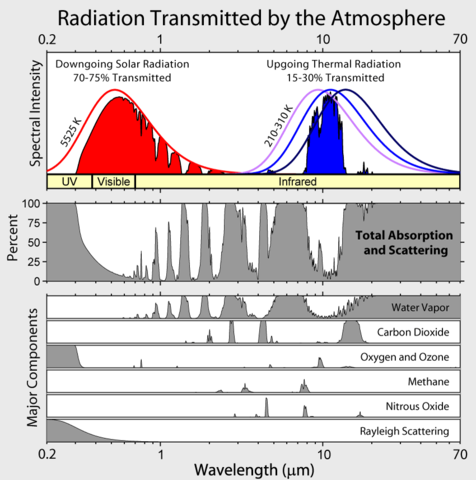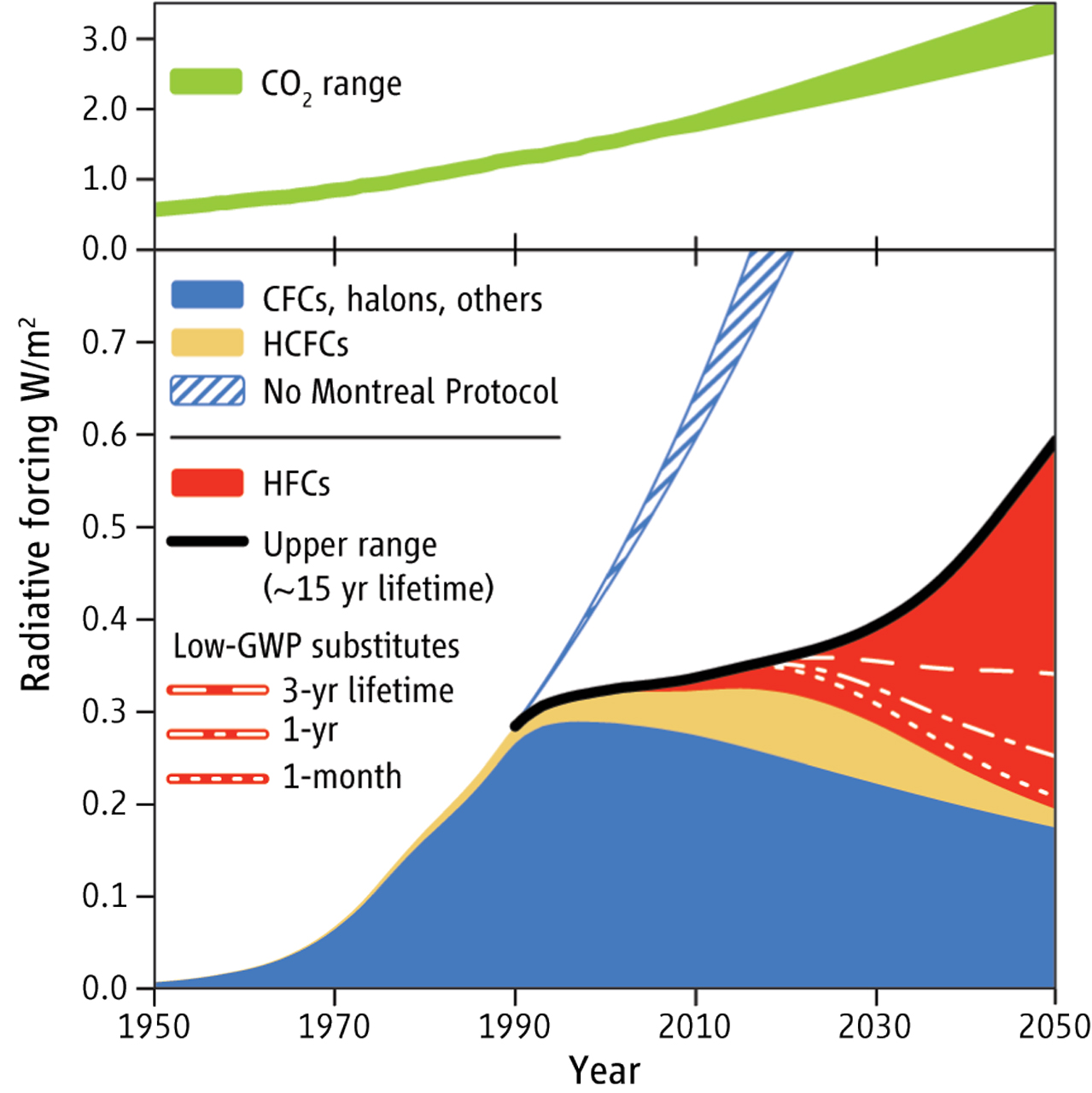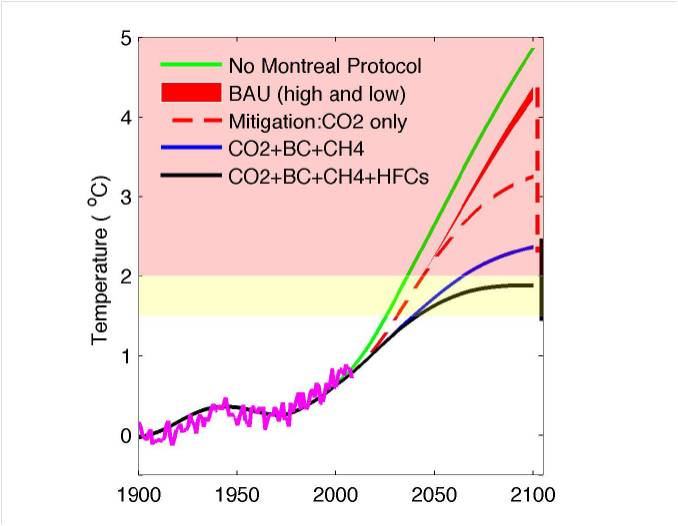Science does inform policy making … sometimes
Posted on 18 July 2013 by gws
When I was a graduate student in the 1990s I attended many scientific seminars. I recall very few of them. One, however, stuck with me because it was revealing about the attitudes of some business people towards important scientific findings. In this case, it was about the infrared (IR) absorption properties of fluorinated hydrocarbons. The Montreal protocol was just a few years old at the time and scientists were looking into the future, investigating the possible effects of replacing those ozone depleting substances (ODSs) with new refrigerants, blowing agents, aerosol sprays, etc. At the end of her talk about those fluorocarbons and their future effects on climate the speaker was asked what the industry thought about her results. She shrugged, then indicated that they knew but did not care.
The science was clear at the time. As early as the 1970s, scientists showed that chlorofluorocarbons (CFCs) were not only a problem for the ozone layer, but that they possessed a property that made them powerful greenhouse gases: the chemical bond between carbon and fluorine is absorbing infrared radiation at wavelengths in a region called the atmospheric window (Figure 1). In this wavelength region, most infrared radiation from Earth’s surface escapes into space. In other words, from space Earth appears very bright at these wavelengths to someone with infrared vision, and darker the more IR radiation is absorbed in the atmosphere. As a result, an atmospheric gas able to absorb anywhere in that “window” has plenty of energy available.
Figure 1: Top Panel – Normalized radiation energy received at Earth’s surface (red, left) and transmitted into space (blue, right) as a function of wavelength in micrometers (1 millionth meter); Middle Panel – Percent radiation absorbed or (back-)scattered in the atmosphere as a function of wavelength; and Bottom Panel: The major components contributing to this wavelength-dependent absorption. The “atmospheric window” is the wavelength region between 8 and 13 micrometer (blue in Top Panel).
The original Montreal Protocol addressed only CFCs as the major ODSs. Their use and production was phased out in the 1990s. Amendments later addressed so-called hydro-chlorofluorocarbons (HCFCs), which are removed partially in the lower atmosphere but still contribute to ozone depletion. As HCFCs are being phased out, they have been replaced by compounds that do not contain chlorine any more, but still fluorine. Most replacements are hydrofluorocarbons, or HFCs. As a result, these compounds are not considered ODSs and are thus not included in the Montreal Protocol. Problem is, they are widely used, very potent greenhouse gases. If your car or home has an air conditioner, there is a good chance its refrigerant is either R134a or R410a (trademarked as Puron, a mix of R32 and R125), which have a global warming potential (GWP) over 1,300 and 2,000 times that of carbon dioxide, respectively.
Both HCFCs and HFCs are man-made compounds that, once released, stay in the atmosphere for a very long time. The industries producing these compounds have been fully aware of this fact for well over a decade, yet HCFC production was, and HFC production is now ramping up rapidly. As leakage to the atmosphere during production, use, and decommissioning is unpreventable, concentrations of these gases in the atmosphere are increasing rapidly (NOAA-ESRL data). At this point in time, these gases represent 1-2% of the anthropogenic greenhouse effect. But their contribution is expected to grow rapidly.
In 2009, Velders et al. showed that the warming from projected HFC emissions by 2050 may become equivalent to 9-19% of CO2 emissions (1). Thus, it could make global warming worse. While an initiative to include HFCs into the Montreal Protocol – in order to phase them out – was begun the same year, no progress was made until last month when during a meeting between US president Obama and Chinese president Xi Jinping an agreement was reached to make another attempt of phasing out HFCs.
The urgency of the matter was illustrated again by Velders et al. publishing this graph in Science in 2012:
Figure 2 (modified from original caption): Projected radiative forcing by ODSs, HFCs, low global warming potential (GWP) substitutes (all lower panel), and CO2 (upper panel). The blue hatched region indicates what would have occurred in the absence of the Montreal Protocol (with 2 to 3% annual ODS production increases). Added to the radiative forcing from ODSs (blue and beige) are the contributions from HFCs from a high emissions scenario (red region, thick black line). Also shown are the radiative forcing from alternative scenarios in which substitution is made with chemicals having shorter lifetimes (i.e. lower GWPs; white lines inside red region). Note that under the Montreal Protocol, use reductions for CFCs started in 1989 and for HCFCs in 1996.
It shows the expected radiative impacts of atmospheric HFCs. A much reduced impact can be realized if HFCs are phased out, or if only a limited subset of HFCs with much shorter atmospheric lifetimes is allowed.
As if to confirm that phasing out HFCs is critical to climate change mitigation, only two weeks after the US-China presidential meeting and parallel to Montreal Protocol discussions in Bangkok, Xu et al. published a study showing the substantial warming avoidable by not allowing the industry to produce long-lived HFCs for the global air conditioning market this century. Here is their projection:
Figure 3 (original caption): Model simulated temperature change under various mitigation scenarios that include CO2 and SLCPs (BC, CH4, HFCs). BAU case (red solid line with spread) considers both high and low estimates of future HFC growths (as shown in red solid and dash lines in Fig. 1). Note this uncertainty of temperature projection related to HFC scenarios is around 0.15 °C at 2100. The vertical bars next to the curve show the uncertainty of temperature projection at 2100 due to climate sensitivity uncertainty. For simplicity, we only show the cases of CO2 mitigation (red dash line) and full mitigation (black line).
The graph shows that the Montreal Protocol has already had a significant impact on global climate through phasing out ODSs, equivalent to potentially half a degree centigrade of extra warming in 2010 had there been modest growth in production and use of CFCs and HCFCs since 1987. If HFCs are not phased out under the Protocol, we may have to face that all over again: an additional half degree warming by 2100, courtesy of the same people in industry who gave us CFCs and HCFCs in the first place. History repeating itself. Mockery ala Greenpeace is understandable.
Here is the good news: There was actual progress at the Montreal Protocol 33rd Working Group meeting in late June in Bangkok to do what is necessary: prevent a build-up of HFC “super-greenhouse gases” in our atmosphere. The meeting did not receive the press echo (yet) one would have expected from the importance of the topic. But there is still time to celebrate that science does inform policy making … sometimes.
Looking again at Figure 3 reminds us though of something heard a lot these days: an “all-of-the-above strategy”. Meaning, all greenhouse gas emissions will have to be mitigated drastically in the next decades to achieve the political 2-degree centigrade goal. Or as Xu et al. worded it:
“It is also important to emphasize that HFC mitigation should not be viewed as an 'alternative' strategy for avoiding the 2 °C warming, but rather as a critical component of a strategy that also requires mitigation of CO2 and the other SLCPs” [short-lived climate pollutants].
(1) note the related error in the White House press release widely repeated in the press: Not the emissions will be equivalent but their effects will be.
References:
M. Roehl, D. Boglu, C. Brühl, and G. K. Moortgat: Infrared band intensities and global warming potentials of CF4, C2F6, C3F8, C4F10, C5F12, and C6F14, Geophys. Res. Lett. vol. 22 (7), 814-818, 1995
G. J. M. Velders, A. R. Ravishankara, M. K. Miller, M. J. Molina, J. Alcamo, J. S. Daniel, D. W. Fahey, S. A. Montzka, and S. Reimann: Preserving Montreal Protocol Climate Benefits by Limiting HFCs, Science vol. 335 (6071), 922-923, DOI: 10.1126/science.1216414, 2012
G. J. M. Velders, S. O. Andersen, J. S. Daniel, D. W. Fahey, and M. McFarland: The importance of the Montreal Protocol in protecting climate, PNAS vol. 104 (12), 4814-4819, 2007
G. J. M. Velders, D. W. Fahey, J. S. Daniel, M. McFarland, and S. O. Andersen: The large contribution of projected HFC emissions to future climate forcing, doi: 10.1073/pnas.0902817106, PNAS June 22, 2009
Y. Xu, D. Zaelke, G. J. M. Velders, and V. Ramanathan: The role of HFCs in mitigating 21st century climate change, Atmos. Chem. Phys., 13, 6083–6089, 2013































 Arguments
Arguments

































I believe that there are hydrocarbon based refrigerants which are very suitable for use in automotive and domestic refrigeration. It is claimed that systems using these are up to 36% more efficient than conventional refrigerants. 8 million refrigerators per year are now produced in Europe using hydrocarbon refrigerant so it is clearly well proven.
There are other alternatives to HFCs such as CO2. This article from Department of Environment and Water Resources in Australia has interesting comparisons and case studies http://www.environment.gov.au/atmosphere/ozone/publications/pubs/refrigerants-guide.pdf
In the past there has been a lot of rather hysterical reaction to the use of hydrocarbon refrigerants, especially in cars with some Australian states banning the use on supposed "safety" grounds. They loved to show a Hollywood style car explosion where a car is filled with LPG and exploded.
Good info. The only question I have is the long-term lifetime of HFC in the athmosphere - are they as stable as CO2 or can they decompose faster?
It is important question, because if they maintain a signifficant residual forcing out of that ~0.5Wm-2 forcing shown on Figure2 for many centuries, then they will amplify CO2 impact at eqilibrium. The resulting fraction of a degree may make a lot of difference on top of CO2 induced warming with respect to Earth system tipping points. Consequently, their immediate reduction is as urgent as the reduction of CO2.
Figure 3 gives me an idea what may happen until 2100, but I'm interested in equilibrium conditions beyond 2100, with an optimistic assumption the emissions drop to zero within 2050 as with the white lines on Figure2.
This is currently in the news again, though overlooked by many outlets:
VOX: The biggest climate change story in the world this week is quietly playing out in Rwanda,
Reuters: U.S. optimistic climate deal will cut HFC gases
Suffice it to say, these are critical negotiations.
I want to highlight that the Vox article author made one big mistake when he said
As I wrote in my article above, the replacements of CFCs with HCFCs, then HFcs was no accident. The industry knew what it was doing, and teh scientists told them that one day these gases would become highly important. So "oops" maybe, but certainly no accident ...
ABC News had an article too: Powerful Greenhouse Gases in Focus at Global Climate Meeting